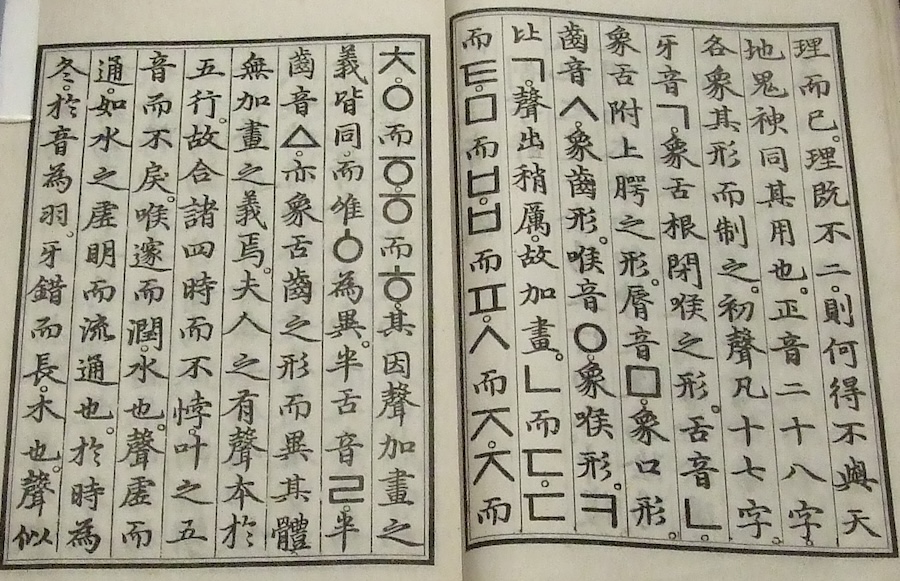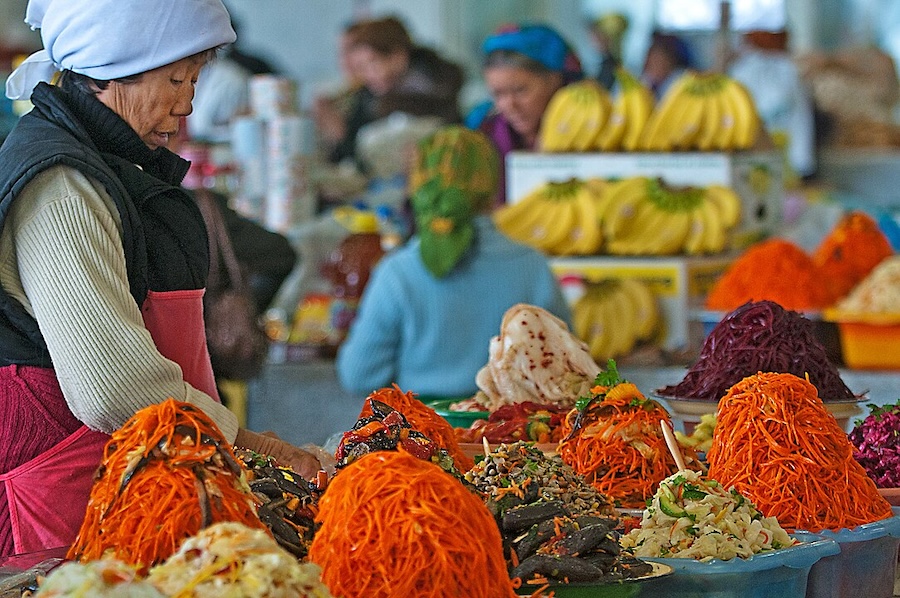Do Koreans Use Hieroglyphs?

Both no and yes. No, because both in the South and the North of the Korean Peninsula, they use their own alphabets. In the Republic of Korea, it is called Hangul, and in the DPRK — Chosongul, and both countries consider it an outstanding achievement of their national culture.
Korean writing has several unique features. For example, the shape of the letters representing consonant sounds schematically reflects the position of the articulatory apparatus when pronouncing the corresponding sound. For instance, the letter ㄱ (read as “k” or “g” depending on its position in the syllable) resembles the position of the tongue when pronouncing this sound.
The shape of the letter ㅇ represents the position of the vocal cords when pronouncing the nasal sound “ng.”
The letters representing vowel sounds use symbols of the three fundamental elements of Korean natural philosophy — heaven, earth, and man. Their combinations demonstrate the central idea of Korean traditional culture — harmony and balanced coexistence of different principles.
Hangul was created in the mid-15th century by King Sejong, who was ruling in Korea at that time (the title “wang” means “king”). Before that, Korean noblemen used Chinese characters for reading and writing: at that time, China was the cultural hegemon, not only in Korea but throughout the Far East region.
King Sejong decided that writing was needed not only for the aristocracy but also for ordinary people, and an alphabet is simpler than hieroglyphics, which takes years to learn. Hangul indeed looks like hieroglyphs, so it is not surprising that they are often confused. This can be explained by the fact that medieval Koreans lived under Chinese cultural influence and, when inventing their writing system, were guided by familiar patterns.
Despite their own alphabet, Koreans did not completely abandon hieroglyphics, continuing to study it in school and use it in life.
Any educated person should know a minimum (for today’s high school graduates, it is 1,800 characters). Additionally, hieroglyphics, along with the national alphabet, is widely used in the scientific field, jurisprudence, and some media.
Are All Koreans Named Kim?
Of course, not all of them, but Kim is indeed the most common Korean surname. According to the 2015 census in South Korea, 21.5% of residents (that is, one-fifth of the country) had this surname. The second most common is Lee (14.7%), followed by Park (8.4%), and then Choi (4.7%). Less common surnames are Jung, Kang, Cho, and Yoon.
All Korean surnames have a hieroglyphic writing, meaning they can be written both with the Korean alphabet and with Chinese characters. There are slightly fewer than three hundred such “family” characters — accordingly, there are about the same number of Korean surnames. But this does not mean that all Kims are related to each other. Each clan has its “bon” — the birthplace of its founder, which is documented for modern Koreans. For example, there are Andong Kims whose ancestor came from Andong, and Gimhae Kims who originated from Gimhae.
The same applies to other surnames. If a couple planning to marry has the same surname but different bons, there will be no problems. If the bons coincide, there may be difficulties — even if the family trees of these people crossed several hundred years ago. Until 1997, such marriages were legally prohibited; now they are still avoided, although the ban has been officially lifted.
Kim Jong-un — Which Is the Surname, the Name, and Is There A Patronymic?

We already mentioned that Kim is the surname. Therefore, the name is Jong-un. Koreans do not have patronymics. Most often, Korean personal names consist of three elements, each read as a syllable. The first syllable is the surname, and the following two are the given name. Occasionally, there are personal names consisting of a single syllable.
In Russian Korean studies, there is a rule that Korean names should be written in two words — first separately the surname, then the given name as one word. This method was proposed in the last century by linguist and orientalist Alexander Alekseevich Kholodovich and his follower Lev Rafailovich Kontsevich. However, despite the rules, many write Korean names in three words.
Confusion is further compounded by the Koreans themselves, especially when they write their names in foreign languages. Adapting to Western norms, they write their given name first, followed by the surname. Additionally, there are several different systems for Romanizing Hangul, which also leads to misunderstandings and errors.
For example, the name of the founder and first leader of the DPRK in his native language sounds like Kim Il Sung (Kim Ilsong). However, due to certain features of Korean phonetics, dialects, and discrepancies in Cyrillic transliteration systems, this name was once written in Russian as Kim Ir Sen, and his son’s name as Kim Jong Il (in the DPRK it sounds like Kim Jong Il). The third Kim — the current leader of North Korea — is now called Kim Jong-un in Russian (the first character in his name is the same as his father’s), whereas in his homeland his name is pronounced as Kim Jong-un.
Why Are There Two Koreas?

This was the result of World War II and the subsequent division of the world into two camps — capitalist and socialist. Japan’s defeat in World War II restored national independence to the Koreans — from 1910 to 1945 Korea was a Japanese colony — but then the victorious countries could not agree on an acceptable future for Korea, resulting in the infamous 38th parallel, which later divided the spheres of influence.
In 1948, the Democratic People’s Republic of Korea (DPRK), supported by the USSR, was established in the north, and the Republic of Korea (ROK), allied with the United States, was established in the south. Each Korea wanted to be the main and only Korea — in the summer of 1950, the Korean War broke out, nearly escalating into World War III. The conflict lasted three years and ended with a temporary truce that remains in place to this day, and the two countries developed independently, still striving to prove to themselves and the world that each is the true Korea.
Are Koreans Buddhists?
According to 2016 statistics, only 16% of the population of the Republic of Korea are Buddhists. There are more Christians (28%), of which 20% are Protestants and only 8% are Catholics. 56% of South Korea’s residents do not adhere to any religious teachings. In the DPRK, freedom of religion is officially declared, but the cult of personality surrounding the country’s leaders and a generally materialistic worldview make any religious activity impossible. The few existing Buddhist monasteries in the country function more like museums.
However, statistics on faith are not the most reliable source. A Western missionary in Korea once said that in their minds, Koreans are Christians, in their hearts, they are Buddhists, and in their stomachs, they are shamanists. Indeed, in the Republic of Korea, shamans (more often shamanesses) and their followers still exist. In big cities, many secular people, when opening a new restaurant or other small business, set a special ritual table, place a pig’s head with a bundle of cash in its mouth on it, and invite a shamaness to perform a ritual to ensure the project’s success.
Moreover, on a personal level, people turn to shamans to restore peace in the family, overcome illness, help a child get into a good university, and the like. Shamans are respected at the state level — they are treated as carriers of traditional culture, paid stipends, and famous shamans go on tours, including abroad. Their dances and chants are studied by ethnographers and musicologists.
Why Is the Carrot “Korean”?

In fact, the carrots and other salads sold in Russian markets and stores as Korean are not quite Korean. At least, neither in South nor in North Korea are they prepared and eaten. All this is the cuisine of Central Asian Koreans who found themselves in the USSR, mainly on the territory of modern Kazakhstan and Uzbekistan, as a result of the deportation of 1937.
In the new, difficult conditions, people tried to cook the familiar food from the products that were at hand. This is how the popular in Russia Korean pickles and snacks appeared. The native food tradition is only related to the method of preparation: in Korea, the basic meal involves a bowl of rice and soup, which are necessarily accompanied by several panchan — side dishes made from pickled vegetables, herbs, salted seafood.
The most famous Korean panchan is the spicy fermented cabbage kimchi. In general, kimchi is made from a variety of ingredients — radish, cucumbers, garlic shoots, sesame leaves, bamboo, and much more. The main thing is that the product is well fermented — otherwise it will not be kimchi.
Do Koreans Really Eat Dogs?
Yes, but not everyone and only on special occasions. Dog meat dishes have never been and are not part of the everyday Korean diet, they are considered a special healing food and are consumed for recovery after illness or severe fatigue, as well as traditionally on the three hottest summer days, determined by the lunar calendar: this helps better withstand the heat. However, today this remedy is resorted to only by the older generation and mainly men, while the young prefer to fight the heat with the help of samgyeopsal – a special chicken soup with ginseng root.
With the spread of Western values and lifestyle in Korea, the practice of eating dogs is losing popularity, but they do not completely abandon it. Society and the authorities consider it more important to introduce reasonable ethical and sanitary standards in the field of keeping and slaughtering the dog breed – now there is really no order in this matter.

